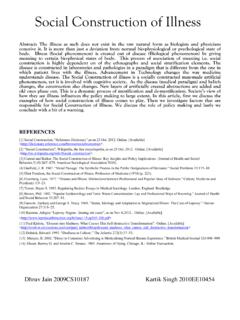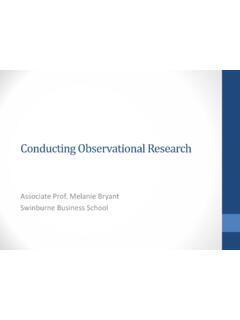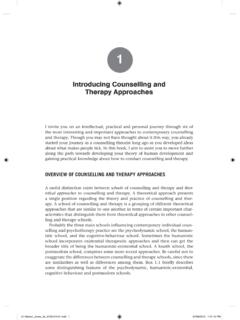Transcription of More Is Different - KIT
1 The reductionist hypothesis may still lbe a topic for controversy among phi- losophers, but among the great majority of active scientists I think it is accepted without question The workings of our minds and bodles, and of all the ani- mate or lnanimate matter of which we have any detailed knowledges are as sumed to be controlled by the same set o fundamental laws which except under certain extreme conditions we feel we know pretty well. It seems inevitable to go on unerit- ically to what appears at first sight to be- an obvious corollary of reduction ism: that if everything obeys the same fundamental laws, then the only sci entists who are studying anything really fundamental are those who are working on those laws. In practice, that amounts to some astrophysicists, some elemen- tary particle physicists, some logicians and other mathematicians, and few others.
2 This point of view, which it is the main purpose of this article to oppose, is expressed in a rather well- known passage by Weisskopf (1): Looking at the development of science in thP Twentieth' Century one can dis tinguish two trends, which I will call sSintensive and "extensive" research, lack- ing a better 'terminology. In short: in- tensive research goes for the fundamental laws, extensive research goes for the ex- The author is a member of the technlical staff of the Bell Telephone Laboratories, Murray Hill, New Je1 sey 07974, and visiting professor of theoretical physics at Cavendish Laboratory, Cambridge, England. This article is an expanded version of a Regents' Lecture given in 1967 at the University of California, La Jolla. 4 AUGUST 1972 4 August 1972, Volume 177, Number 4047 less relevance they seem to have to the very real problems of the rest of sci- ence, much less to those of society.
3 The constructionist hypothesis breaks down when confronted with the twin difficulties of scale and complexity. The behavior of large and complex aggre- gates of elementary particles, it turns out, is not to be understood in terms of a simple extrapolation of the prop- erties of a few particles. Instead, at each level of complexity entirely new properties appear, and the understand- ing of the new behaviors requires re- search which I think is as fundamental in its nature as any other. That is, it seems to me that one may array the sciences roughly linearly in a hierarchy, according to the idea The elementary entities of science X obey the laws of science Y planatlon - of phenomena ;n terms of lnown fundamental laws. As always, dis- tinotions of this kind are not unambiguous, but they are clear in most cases. Solid state physics, plasma physics, and perhaps also biology are extensivee High energy physics and a good part of nuclear physics are intensive.
4 There is always much less intensive research going on than extensive. Once new fundamental laws are discov- ereds a large and ever increasing activity begins in order to apply the discoveries to hitherto unexplained phenomena. Thus, there are two dimensions to basic re- search The frontier of science extends all along a long line from the newest and most modern intenslve research5 over the ex- tensive research recently spawned by the intensive research of yesterday, to the broad and well developed web of exten- sive research activities based on mtensive research of past decades. The effectiveness of this message may be indicated by the fact that I heard it quoted recently by a leader in the field of materials science, who urged the participants at a meeting dedicated to "fundamental problems in condensed matter physics" to accept that there were few or no such problems and that nothing was left but extensive scienceS which he seemed to equate with device.
5 @ englneerlng. The main fallacy in this kind of thinking is that the reductionist hypoth- esis does not by any rneans imply a " constructionist " one: The ability to reduce everything to simple fundamen- tal laws does not imply the ability to start from those laws and reconstruct the universe. In fact, the more the ele-- mentary particle physicists tell us about the nature of the fundamental laws the Xsolid state or many-body physics chemistry mo-lecular biology cell biology .. * psychology * .. soclal sclences y elementary particle physics many-body physics chemistry molecular biology * physlology psychology But this hierarchy does not imply that science X is "just applied Y*" At each stage entirely new laws, concepts, and generalizations are necessary, re- qulring inspiration and creativity to just as great a degree as in the previous one. Psychology is not applied biology, nor s biology applied chemistry.
6 In my own field of many-body physB ics, we are, perhaps, closer to our fun damental, intensive underpinnings than in any other science in which non- trivial complexities occur, and as a re- sult we have begun to formulate a general theory of just how this shift from quantitative to qualitative differ- entiation takes place. This formulation, called the theory of "broken sym- metry," may be of help in making more generally clear the breakdown of the constructionist converse of reduction- ism. I will give an elementary and in complete explanation of these ideas, and then go on to some more general spec- ulative comments about analogies at 393 SCIE:NC1S more Is Different Broken symmetry and the nature of the hierarchical structure of science P. W. Anderson other levels and about similar phe- nomena. Before beginning this I wish to sort out two possible sources of misunder- standing.
7 First, when I speak of scale change causing fundamental change I do not mean the rather well-understood idea that phenomena at a new scale may obey actually Different fundamen- tal laws as, for example, general rela- tivity is required on the cosmological scale and quantum mechanics on the atomic. I think it will be accepted that all ordinary matter obeys simple elec- trodynamics and quantum theory, and that really covers most of what I shall discuss. (As I said, we must all start with reductionism, which I fully ac- cept.) A second source of confusion may be the fact that the concept of broken symmetry has been borrowed by the elementary particle physicists, but their use of the term is strictly an analogy, whether a deep or a specious one remaining to be understood. Let me then start my discussion with an example on the simplest possible level, a natural one for me because I worked with it when I was a graduate student: the ammonia molecule.
8 At that time everyone knew about ammonia and used it to calibrate his theory or his apparatus, and I was no exception. The chemists will tell you that ammonia "is" a triangular pyramid N (-) zz,,;H (+) | p (+ ) H H (+) with the nitrogen negatively charged and the hydrogens positively charged, so that it has an electric dipole mo- ment (,u), negative toward the apex of the pyramid. Now this seemed very strange to me, because I was just being taught that nothing has an electric die pole moment. The professor was really proving that no nucleus has a dipole moment, because he was teaching nu- clear physics, but as his arguments were based on the symmetry of space and time they should have been correct in general. I soon learned that, in fact, they were correct (or perhaps it would be more accurate to say not lncorrect) because he had been careful to say that no stationary state of a system (that is, one which does not change in time) has an electric dipole moment.
9 If am- monia starts out from the above unw symmetrical state, it will not stay in it very long. By means of quantum me- chanical tunneling, the nitrogen ean 394 leak through the triangle of hydrogens to the other side, turning the pyramid inside out, and, in fact, it can do so very rapidly. This is the so-called "in- version," which occurs at a frequency of about 3 X 101 per second A truly stationary state can only be an equal superposition of the unsyrnmetri- cal pyramid and its inverse. That mix- ture does not have a dipole moment. (I warn the reader again that I am greatly oversimplifying and refer him to the textbooks for details.) I will not go through the proof, but the result is that the state of the system, if it is to be stationary, must always have the same symmetry as the laws of motion which govern it. A reason may be put very simply: In quantum me- chanics there is always a way, unless symmetry forbids, to get from one state to another.
10 Thus, if we start from any one unsymmetrical state, the system will make transitions to others, so only by adding up all the possible unsymmet- rical states in a symmetrical way can we get a stationary state. The symmetry involved in the case of ammonia is parity, the equivalence of left- and right-handed ways of looking at things. (The elementary particle experimental- ists' discovery of certain violations of parity is not relevant to this question; those effects are too weak to affect ordinary matter.) Having seen how the ammonia mol- ecule satisfies our theorem that there is no dipole moment, we may look into other cases and, in particular, study progressively bigger systerns to see whether the state and the symmetry are always related. There are other similar pyramidal molecules, made of heavier atoms. Hydrogen phosphide, PH3, which is twice as heavy as ammonia, inverts, but at one-tenth the ammonia frequency.






